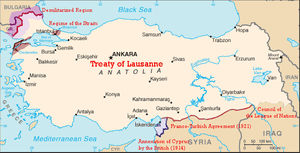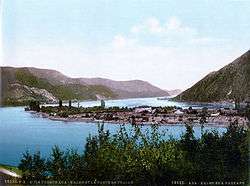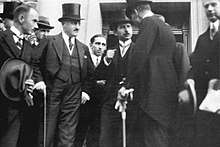Treaty of Lausanne
The Treaty of Lausanne (French: Traité de Lausanne) was a peace treaty negotiated during the Lausanne Conference of 1922–23 and signed in the Palais de Rumine,[1][2] Lausanne, Switzerland, on 24 July 1923. It officially settled the conflict that had originally existed between the Ottoman Empire and the Allied French Republic, British Empire, Kingdom of Italy, Empire of Japan, Kingdom of Greece, and the Kingdom of Romania since the onset of World War I.[3] The original text of the treaty is in French.[3] It was the result of a second attempt at peace after the failed Treaty of Sèvres. The earlier treaty had been signed by all previous parties, except the Kingdom of Greece, but later rejected by the Turkish national movement who fought against its terms. The Treaty of Lausanne ended the conflict and defined the borders of the modern Turkish Republic. In the treaty, Turkey gave up all claims to the remainder of the Ottoman Empire and in return the Allies recognized Turkish sovereignty within its new borders.[3] It provided for the Greek-Turkish population exchange and allowed unrestricted civilian and military passage through the Turkish Straits.
Long name:
| |
|---|---|
 Borders of Turkey set by the Treaty of Lausanne | |
| Signed | 24 July 1923 |
| Location | Lausanne, Switzerland |
| Effective | 6 August 1924 |
| Condition | Following ratification by Turkey and any three of the United Kingdom, France, Italy and Japan, the treaty would come into force for those "high contracting parties" and thereafter for each additional signatory upon deposit of ratification |
| Signatories |
|
| Depositary | French Republic |
| Language | French |
The treaty was ratified by Turkey on 23 August 1923,[4][5] [4][5][5] and all of the other signatories by 16 July 1924.[6] It came into force on 6 August 1924, when the instruments of ratification were officially deposited in Paris.[3]
Background

After the withdrawal of the Greek forces in Asia Minor and the expulsion of the Ottoman sultan by the Turkish army under the command of Mustafa Kemal Atatürk, the Ankara-based Kemalist government of the Turkish National Movement rejected the territorial losses imposed by the 1920 Treaty of Sèvres previously signed by the Ottoman Empire. Britain had sought to undermine Turkish influence in Mesopotamia and Kirkuk by seeking the creation of a Kurdish state in Eastern Anatolia. Secular Kemalist rhetoric relieved some of the international concerns about the future of Armenians who had survived the 1915 Armenian genocide, and support for Kurdish self determination similarly declined. Under the Treaty of Lausanne, signed in 1923, Eastern Anatolia became part of modern-day Turkey, in exchange for Turkey's relinquishing Ottoman-era claims to the oil-rich Arab lands.[7]
Negotiations were undertaken during the Conference of Lausanne. İsmet İnönü was the chief negotiator for Turkey. Lord Curzon, the British Foreign Secretary of that time, was the chief negotiator for the Allies, while Eleftherios Venizelos negotiated on behalf of Greece. The negotiations took many months. On 20 November 1922, the peace conference was opened; the treaty was signed on 24 July after eight months of arduous negotiation, punctuated by several Turkish withdrawals. The Allied delegation included U.S. Admiral Mark L. Bristol, who served as the United States High Commissioner and supported Turkish efforts.[8]
Stipulations
The treaty was composed of 143 articles with major sections including:[9]
| Parts |
|---|
| Convention on the Turkish Straits |
| Trade (abolition of capitulations) – Article 28 provided: "Each of the High Contracting Parties hereby accepts, in so far as it is concerned, the complete abolition of the Capitulations in Turkey in every respect."[10] |
| Agreements |
| Binding letters |
The treaty provided for the independence of the Republic of Turkey but also for the protection of the Greek Orthodox Christian minority in Turkey and the Muslim minority in Greece. However, most of the Christian population of Turkey and the Turkish population of Greece had already been deported under the earlier Convention Concerning the Exchange of Greek and Turkish Populations signed by Greece and Turkey. Only the Greeks of Constantinople, Imbros and Tenedos were excluded (about 270,000 at that time),[11] and the Muslim population of Western Thrace (about 129,120 in 1923.)[12] Article 14 of the treaty granted the islands of Imbros (Tr. Gökçeada) and Tenedos (Tr. Bozcaada) "special administrative organisation", a right that was revoked by the Turkish government on 17 February 1926. Turkey also formally accepted the loss of Cyprus (which was leased to the British Empire following the Congress of Berlin in 1878, but de jure remained an Ottoman territory until World War I). Egypt and Anglo-Egyptian Sudan (both of which had been occupied by British forces with the pretext of "putting down the Urabi Revolt and restoring order" in 1882, but de jure remained Ottoman territories until World War I) were given to the British Empire, which had unilaterally annexed them on 5 November 1914.[3] The fate of the province of Mosul was left to be determined through the League of Nations. Turkey also explicitly renounced all claims to the Dodecanese Islands, which Italy had been obliged to return to Turkey according to Article 2 of the Treaty of Ouchy in 1912 following the Italo-Turkish War (1911–1912).[13][14]
Summary of Contents of Treaty
| Parts | Sections |
|---|---|
| Preamble | |
| Part I | Political Clauses |
| Part II | Financial Clauses |
| Part III. | Economic clauses |
| Part IV | Communications and Sanitary Questions |
| Part V. | Miscellaneous Provisions |
| Part IV. | Convention respecting conditions of Residence and Business and Jurisdiction |
| Part V | Commercial Convention |
| Part VI | Convention concerning the Exchange of Greek and Turkish Populations |
| Part VII | Agreement between Greece and Turkey respecting the reciprocal restitution of interned civilians and the exchange of prisoners of war |
| Part VIII | Declaration relating to the Amnesty |
| Part IX | Declaration relating to Moslem properties in Greece |
| Part X | Declaration relating to sanitary matters in Turkey |
| Part XI | Declaration relating to the administration of justice in Turkey |
| Part XII | Protocol relation to certain concessions granted in the Ottoman Empire |
| Part XIII | Protocol relating to the accession of Belgium and Portugal to contain provisions and instruments signed at Lausanne |
| Part XIV | Protocol relating to the evacuation of the Turkish territory occupied by the British, French and Italian forces |
| Part XV | Protocol relative to the Karagatch territory and the Islands of Imbros and Tenedos |
| Part XVI | Protocol relative to the Treaty concluded at Sèvres between the principal Allied Powers and Greece on 10 August 1920, concerning the protection of minorities in Greece, and the Treaty concluded on the same day between the same Powers relating to Thrace. |
| Part XVII | Protocol relating to signature by the Serb-Croat-Slovene State |
Borders

The treaty delimited the boundaries of Greece, Bulgaria, and Turkey. The major issue of the war reparations, demanded from Greece by Turkey, was abandoned after Greece agreed to grant Karaağaç to Turkey.
Turkey also formally ceded all claims on the Dodecanese Islands (Article 15); Cyprus (Article 20);[17] Egypt and Sudan (Article 17); Syria and Iraq (Article 3); and (along with the Treaty of Ankara) settled the boundaries of the latter two nations.[3]
The territories to the south of Syria and Iraq on the Arabian Peninsula which still remained under Turkish control when the Armistice of Mudros was signed on 30 October 1918, were not explicitly identified in the text of the treaty. However, the definition of Turkey's southern border in Article 3 also meant that Turkey officially ceded them. These territories included Yemen, Asir and parts of Hejaz like the city of Medina. They were held by Turkish forces until 23 January 1919.[18][19]
By Articles 25 and 26 of the Treaty of Lausanne, Turkey officially ceded Adakale Island in the Danube River to Romania by formally recognizing the related provisions in the Treaty of Trianon of 1920.[3][16] Due to a diplomatic irregularity at the 1878 Congress of Berlin, the island had technically remained part of the Ottoman Empire.
Turkey also renounced its privileges in Libya which were defined by Article 10 of the Treaty of Ouchy in 1912 (per Article 22 of the Treaty of Lausanne in 1923.)[3]
Agreements
Among many agreements, there was a separate agreement with the United States: the Chester concession. In the United States, the treaty was opposed by several groups, including the Committee Opposed to the Lausanne Treaty (COLT), and on 18 January 1927, the United States Senate refused to ratify the treaty by a vote of 50–34, six votes short of the two-thirds required by the Constitution,[20] and consequently Turkey annulled the concession.[9]
Aftermath

The Treaty of Lausanne led to the international recognition of the sovereignty of the new Republic of Turkey as the successor state of the defunct Ottoman Empire.[3] The Convention on the Straits lasted only thirteen years and was replaced with the Montreux Convention Regarding the Regime of the Straits in 1936. The customs limitations in the treaty were shortly after reworked.
Hatay Province remained a part of the French Mandate of Syria according to the Treaty of Lausanne, but in 1938 gained its independence as the Hatay State, which later joined Turkey after a referendum in 1939. Political amnesty was given to opponents of the new Turkish regime but the government reserved the right to make 150 exceptions.[21] The 150 personae non gratae of Turkey (mostly descendants of the Ottoman dynasty) slowly acquired citizenship – the last one in 1974.
Debate
President Recep Tayyip Erdoğan of Turkey seeks to institute certain revisions in the Treaty of Lausanne.[22] He laments the content of the treaty that forced Turkey to cede the Aegean islands to Greece.[23]
See also
| Wikisource has original text related to this article: |
Notes and references
- "Palais de Rumine". www.lonelyplanet.com. Retrieved 6 September 2018.
- "Palais de Rumine & Musée cantonal des Beaux-Arts". MySwitzerland.com. Retrieved 6 September 2018.
- Treaty of Peace with Turkey signed at Lausanne, Lausanne, Switzerland, 24 July 1923, retrieved 28 November 2012
- "League of Nations, Official Journal". 4. October 1924: 1292. Cite journal requires
|journal=(help) - Martin Lawrence (1924). Treaties of Peace, 1919–1923. I. Carnegie Endowment for International Peace. p. lxxvii.
- Hansard, House of Commons, 16 July 1924.
- Darren L. Logan (2009). "Thoughts on Iraqi Kurdistan: Present Realities, Future Hope". Iran & the Caucasus. 13 (1): 161–186. JSTOR 25597401.
- Morgenthau, Henry, Ambassador Morgenthau's Story, (Detroit: Wayne State University, 2003), 303.
- Mango, Andrew (2002). Ataturk: The Biography of the Founder of Modern Turkey. Overlook Press. p. 388. ISBN 1-58567-334-X.
- In addition to Turkey, the British Empire, France, Italy, Japan, Greece, Romania and the Kingdom of Yugoslavia were parties to the Treaty.
- The Greek minority of Turkey – Hellenic Resources Network
- Öksüz 2004, 255
- Treaty of Ouchy (1912), also known as the First Treaty of Lausanne
- James Barros, The Corfu Incident of 1923: Mussolini and The League of Nations, Princeton University Press, 1965 (reprinted 2015), ISBN 1400874610, p. 69
- "Treaty Summary".
- Adakale Island in River Danube
- Xypolia, Ilia (2011). "Cypriot Muslims among Ottomans, Turks and British" (PDF). Bogazici Journal. 25 (2): 109–120. Retrieved 10 November 2012.
- "ARABIA (YEMEN-HEJAZ) FRONT SIDE". www.osmanli700.gen.tr. Retrieved 6 September 2018.
- "ARABİSTAN CEPHESİ – Osmanlı Web Sitesi – FORSNET". www.osmanli700.gen.tr. Retrieved 6 September 2018.
- Roger R. Trask, United States Response to Turkish Nationalism and Reform, 1914–1939, Chapter, "Rejection of the Lausanne Treaty and Resumption of Diplomatic Relations, 1923–1927", Excerpt, http://muse.jhu.edu . Accessed 2019 August 5.
- Zürcher Erik Jan. Turkey: a Modern History. 4th ed. London: I.B. Tauris, 2017. p. 163
- "Treaty Debate".
- "Erdogan considers the Treaty of Lausanne a defeat". Independent Balkan News Agency. 30 September 2016. Retrieved 22 March 2020.
External links
- Full text of the Treaty of Lausanne (1923)
- Newspaper clippings about Treaty of Lausanne in the 20th Century Press Archives of the ZBW